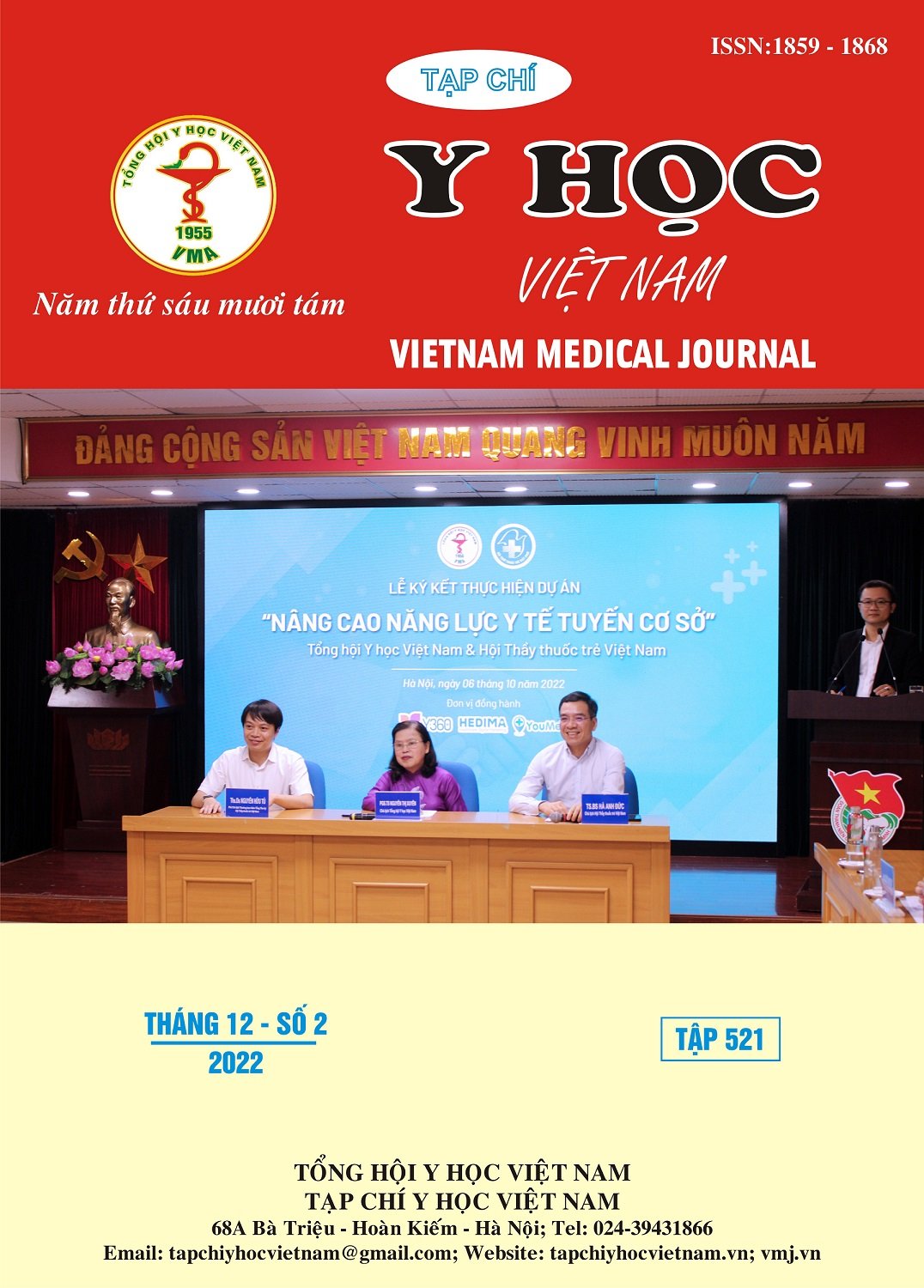ĐÁNH GIÁ SỰ THAY ĐỔI CỦA TÂN MẠCH TRÊN OCTA SAU TIÊM NỘI NHÃN BEVACIZUMAB ĐIỀU TRỊ THOÁI HÓA HOÀNG ĐIỂM TUỔI GIÀ
Nội dung chính của bài viết
Tóm tắt
Mục tiêu: Đánh giá sự thay đổi của tân mạch trên OCTA sau tiêm Bevacizumab điều trị thoái hóa hoàng điểm tuổi già. Đối tượng và phương pháp nghiên cứu: Nghiên cứu mô tả tiến cứu trên 28 mắt của 27 bệnh nhân thoái hóa hoàng điểm tuổi già thể tân mạch có chỉ định tiêm nội nhãn Bevacizumab sau 1 tháng, 2 tháng, 3 tháng, từ tháng 10/2021 đến hết tháng 8/2022 tại Khoa Mắt – Bệnh viện Lão Khoa Trung Ương. Kết quả: 28 mắt bị bệnh của 27 bệnh nhân gồm 3 loại tân mạch: Loại 1, loại 2 và loại 3, trong đó tân mạch hắc mạc (CNV) loại 1 chiếm tỉ lệ cao nhất 75%, loại 2 chiếm 21,4 % và loại 3 chiếm 3,6%. Về mặt định tính, hình dạng tân mạch có sự thay đổi rõ rệt sau 3 tháng tiêm Bevacizumab, từ những tân mạch có hình dạng rõ rệt như dang có mạch gốc trung tâm (medusa), quạt san hô (seafan) đến sự giảm dần và biến mất của hệ thống mao mạch xung quanh và mạch phân nhánh nhỏ tuy nhiên mạch gốc trung tâm ít bị biến đổi. Về mặt định lượng,diện tích tân mạch trung bình đo được là 1,54±0.89 mm2, sau liều nạp diện tích giảm 39,6% xuống 0,93 ±0,7mm2. Mật độ mạch máu, mật độ tưới máu vùng trung tâm thấp hơn vùng quanh trung tâm và tổng hợp, sau 3 tháng nhìn chung các thông số này đều giảm tuy nhiên sự giảm này không có ý nghĩa thống kê. Kết luận: OCTA cung cấp hình ảnh chi tiết về các đặc điểm định tính, định lượng của CNV, với độ tin cậy và an toàn cao cho phép chúng ta khảo sát lặp lại nhiều lần trong suốt quá trình theo dõi điều trị. Dưới tác dụng của Bevacizumab sau liều nạp thấy tân mạch có những thay đổi đáng kể về cả hình dạng và kích thước trên OCTA.
Chi tiết bài viết
Từ khóa
Tân mạch hắc mạc, thoái hóa hoàng điểm tuổi già, tiêm nội nhãn Bevacizumab, chụp OCTA.
Tài liệu tham khảo
2. Savastano MC, Lumbroso B, Rispoli M. IN VIVO CHARACTERIZATION OF RETINAL VASCULARIZATION MORPHOLOGY USING OPTICAL COHERENCE TOMOGRAPHY ANGIOGRAPHY. Retina. 2015;35(11):2196-2203.
3. Tew TB, Lai TT, Hsieh YT, Ho TC, Yang CM, Yang CH. Comparison of different morphologies of choroidal neovascularization evaluated by ocular coherence tomography angiography in age-related macular degeneration. Clin Exp Ophthalmol. 2020;48(7):927-937.
4. Karacorlu M, Sayman Muslubas I, Arf S, Hocaoglu M, Ersoz MG. Membrane patterns in eyes with choroidal neovascularization on optical coherence tomography angiography. Eye (Lond). 2019;33(8):1280-1289.
5. Faatz H, Farecki ML, Rothaus K, Gutfleisch M, Pauleikhoff D, Lommatzsch A. Changes in the OCT angiographic appearance of type 1 and type 2 CNV in exudative AMD during anti-VEGF treatment. BMJ Open Ophthalmol. 2019;4(1).
6. Coscas F, Cabral D, Pereira T, et al. Quantitative optical coherence tomography angiography biomarkers for neovascular age-related macular degeneration in remission. PLoS One. 2018;13(10):e0205513.
7. McClintic SM, Gao S, Wang J, et al. Quantitative Evaluation of Choroidal Neovascularization under Pro Re Nata Anti–Vascular Endothelial Growth Factor Therapy with OCT Angiography. Ophthalmol Retina. 2018; 2(9):931-941.
8. Cennamo G, Montorio D, D’Alessandro A, Napolitano P, D’Andrea L, Tranfa F. Prospective Study of Vessel Density by Optical Coherence Tomography Angiography After Intravitreal Bevacizumab in Exudative Age-Related Macular Degeneration. Ophthalmol Ther. 2020; 9(1):77-85.


